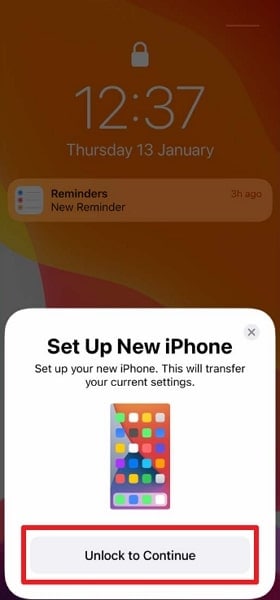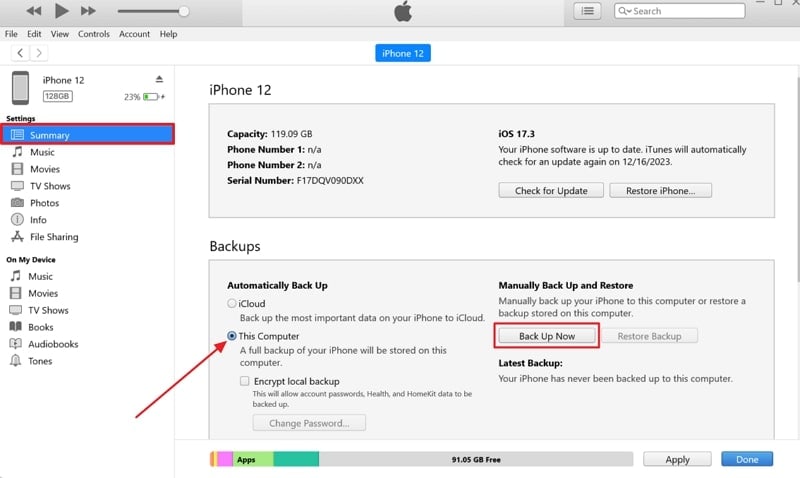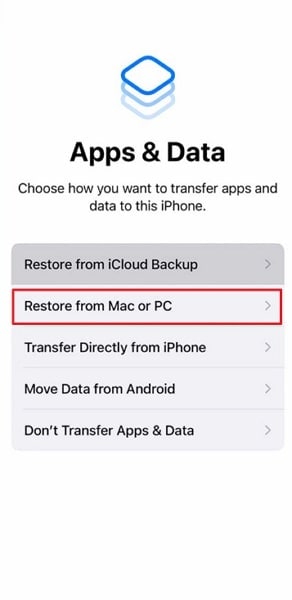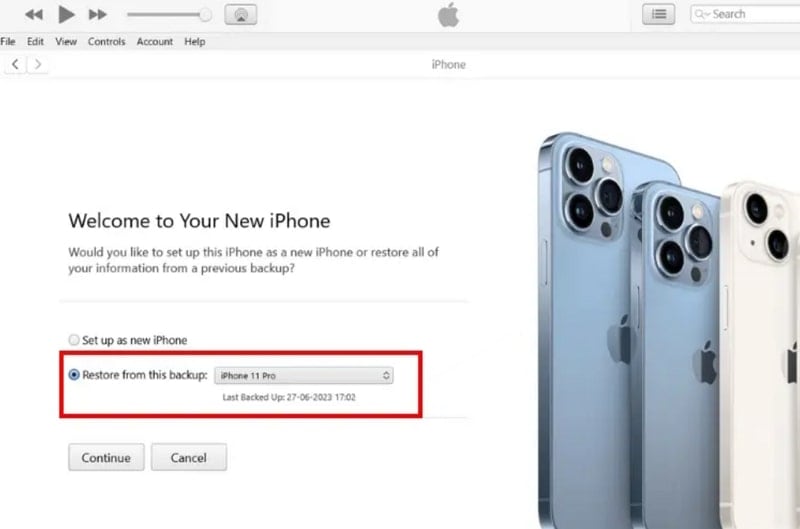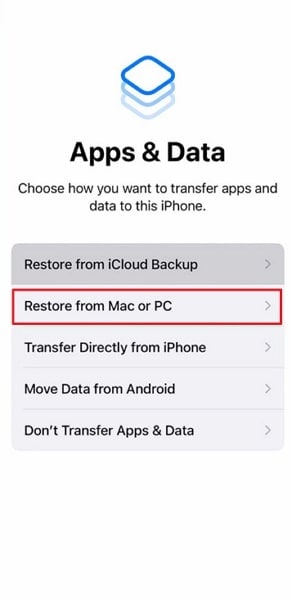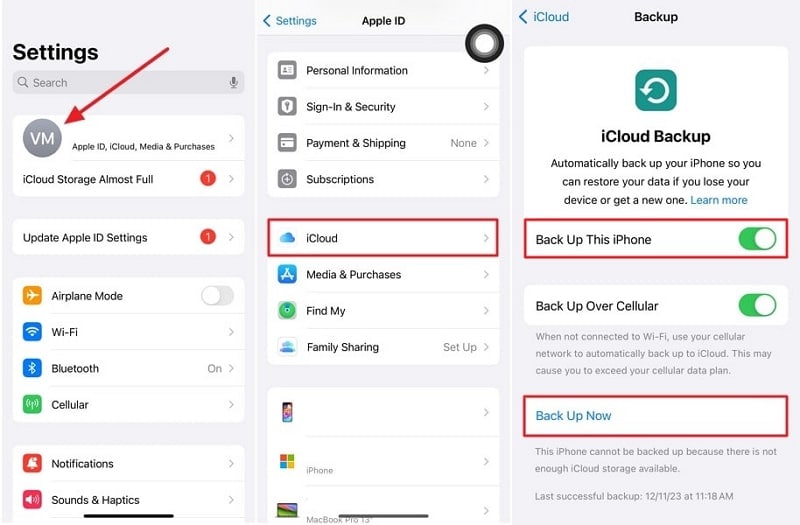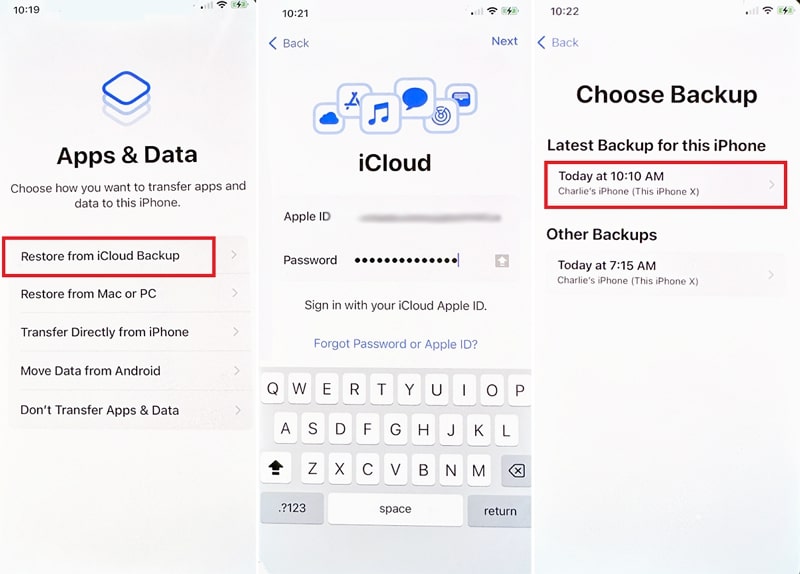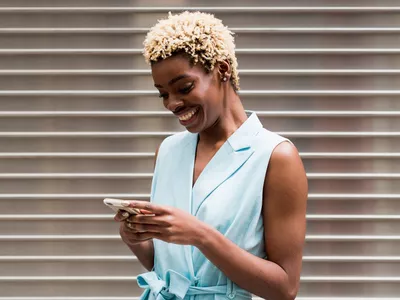
In 2024, How to Copy Contacts from Apple iPhone 11 to SIM? | Dr.fone

How to Copy Contacts from Apple iPhone 11 to SIM?
“How to copy contacts from Apple iPhone 11 to SIM? I want to use my SIM on another device but can’t seem to export contacts to SIM on iPhone!”
Lately, lots of iPhone users have asked similar questions as they wish to save contacts to SIM card on iPhone. It might sound surprising, but it can be a little complicated to learn how to save contacts to SIM on iPhone. In this tutorial, we will answer the question – how to transfer contacts from Apple iPhone 11 to SIM and provide a foolproof way to save and restore your iPhone contacts. Let’s get it started and learn more about how to export contacts from Apple iPhone 11 to SIM.
Part 1: Is it possible to save contacts to SIM on iPhone?
A lot of users take the assistance of SIM card to save their contacts. If you are also doing the same, then you can easily learn how to import SIM contacts to iPhone. Simply go to your device’s Settings > Mail, Contacts, Calendar and tap on “Import SIM Contacts”.

Though, the problem occurs when users wish to do vice versa and learn how to import contacts from Apple iPhone 11 to SIM. As of now, Apple doesn’t provide a direct solution to export contacts to SIM on iPhone. If you really wish to save contacts to SIM on iPhone, then you have to jailbreak your device once. After jailbreaking your device, you can use certain apps to move contacts to SIM easily.
Though, if your device has not been jailbroken, then you can’t export contacts to SIM on iPhone directly. This is because Apple assumes the transfer of contacts via SIM card is an obsolete method. Don’t worry – you can try an alternative method to save and backup contacts on iPhone. We have discussed it in the next section.
Part 2: How to save iPhone contacts with Dr.Fone?
While we can’t learn how to copy contacts from Apple iPhone 11 to SIM, we can try an alternative method to save our contacts. By taking the assistance of Dr.Fone - Backup & Restore (iOS), you can save your data by taking its backup. Later, you can restore the backup on any other iOS (or Android) device. In this way, you can easily move your contacts and don’t need to learn how to save contacts to SIM on iPhone.
Dr.Fone - Backup & Restore (iOS) is a highly advanced and intuitive tool that can backup and restore all the major data types like contacts, messages, photos, music, etc. It is compatible with every leading version of iOS (including iOS 17). Therefore, instead of learning how to transfer contacts from Apple iPhone 11 to SIM, you can use Dr.Fone Backup & Restore by following these steps:
Dr.Fone - Backup & Restore (iOS)
Save and Backup iPhone Contacts with 1-Click.
- One click to backup the whole iOS device to your computer.
- Support to backup Social apps on iOS devices, such as WhatsApp, LINE, Kik, Viber.
- Allow to preview and restore any item from the backup to a device.
- Export what you want from the backup to your computer.
- No data loss on devices during the restore.
- Selectively backup and restore any data you want.
- Supported iPhone 15/14/13/12/11/X that run iOS 17/16/15/14/13 and former
- Fully compatible with Windows 10 or Mac 14
3981454 people have downloaded it
1. Firstly, download Dr.Fone - Backup & Restore(iOS) on your computer and launch it whenever you wish to learn how to export contacts from iPhone (by taking its backup). From the welcome screen of Dr.Fone toolkit, select the option of “Backup & Restore”.

2. Now, connect your iPhone to the system and wait for the application to detect it automatically.
3. You can see that the tool can backup tons of applications as well. Simply click on the “Backup” button on the right panel to get things started.
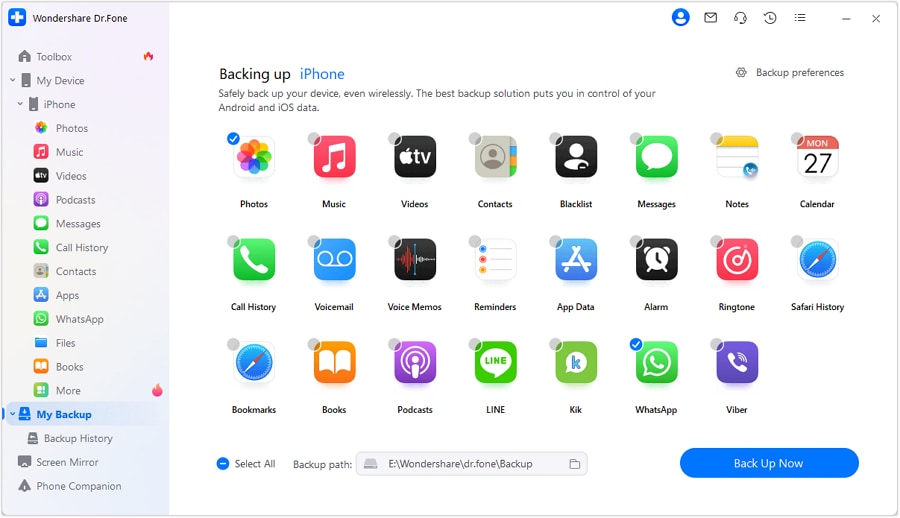
4. From the next window, you can select the type of data that you wish to backup. You can also check the “Select all” option to take a comprehensive backup of your data. Additionally, you can alter the backup path from here as well.
5. To backup contacts, make sure the option of “Contacts” (under the Privacy section) is enabled before you click on the Backup button.

6. Wait for a while as Dr.Fone will backup your selected data. Once it is done, you will be notified. You can either view the backup content or go to the Backup location as well.

7. Whenever you need to restore your contacts, you can simply connect the Apple iPhone 11 device and click on the “Restore” option instead.

8. This will automatically display a list of the previous backup files. Select the file you wish to restore and click on the “View” button.
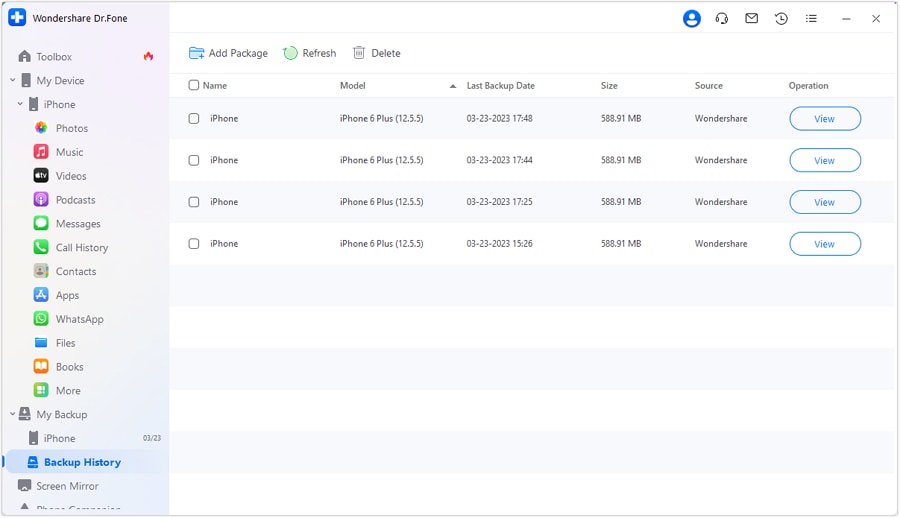
9. Your backup will be listed under different categories here. Go to Privacy > Contacts and select the contacts you wish to restore.
10. After making your selection, you can export this data to your PC or restore it to the connected device. Simply click on the “Restore to Device” and wait for a while.

11. In no time, your contacts would be restored to your device. When the process is completed, you will be notified.
That’s it! After restoring your contacts, you can safely remove the Apple iPhone 11 device and use it as per your wishes. Therefore, if you have Dr.Fone Backup & Restore, then you don’t need to worry about how to import contacts from Apple iPhone 11 to SIM.
Part 3: Other solutions to transfer iPhone contacts
While you can’t learn how to copy contacts from Apple iPhone 11 to SIM directly, you can always move your contacts from one phone to another. We have listed some easy solutions to help you resolve your query on how to save contacts to SIM on iPhone with some alternative methods.
Save your contacts to iCloud
By default, every user gets a free space of 5 GB on iCloud (which can later be expanded). Therefore, you can easily take a backup of your contacts and other important files on iCloud. Just go to your device’s Settings > iCloud and turn the backup option on. Make sure that the backup for Contacts is turned on as well. This will sync your contacts to iCloud, letting you access them on the go. In this way, you don’t have to learn how to transfer contacts from Apple iPhone 11 to SIM.

Export iPhone contacts Via iTunes
Another alternative to learning how to export contacts from Apple iPhone 11 to SIM is by taking the assistance of iTunes. Simply connect your Apple iPhone 11 to the system and launch iTunes. Select your iPhone and go to its “Info” tab. From here, you can sync its contacts with iTunes. This will keep your contacts safe and allow you to sync them with another iOS device.

Copy iPhone Contacts Using Gmail
Just like iCloud, you can also sync your contacts with Gmail. If you don’t use Gmail, then go to your iPhone’s Accounts Settings and set up your Gmail account. Later, you can go to Settings > Mail, Contacts, Calendar > Gmail and toggle on the syncing option for Contacts.

If you want, you can access your Google Contacts and import them to a vCard as well. This would be a perfect alternative to learn how to import contacts from Apple iPhone 11 to SIM.

We hope this guide was able to answer your question of how to copy contacts from Apple iPhone 11 to SIM. Since there is no ideal solution for it, you can try different alternatives. Dr.Fone Backup & Restore is one of the best ways to keep your contacts (and other types of data) safe and will certainly save the day during an emergency situation.
Should I Switch From iPhone To Google Pixel?
The battle between smartphone giants has been a consistent source of intrigue for consumers. Through every new launch, tech giants such as Apple and Google introduce impressive functions. These allure users with the prospect of improved efficiency and seamless usability. This prompts the fundamental query of whether one should consider switching from an iPhone to a Pixel.
Amid the ongoing discourse about these two devices, it becomes imperative to go through the advantages and disadvantages inherent to each. This serves to equip you with the necessary insights for making a choice that aligns with your preferences. In this guide, we will explore the key considerations to contemplate when switching from an iPhone to a Google Pixel.
Part 1: What Is The Google Pixel?
An Android smartphone launched by Google in 2016, Google Pixel was designed to replace the Nexus. Similar to Nexus, the Pixel operates a “stock version” of Android, which means that it gets updates as soon as they’re released. Other Android smartphones sometimes delay updates for weeks or even months. The Google Pixel comes with free unlimited photo storage on Google Photos. Additionally, Google Photos for the Pixel doesn’t compromise the photo quality in order to save room. Well, there is much more to explore about Google Pixel.
Key Specifications-
- OS- Android 7.1 and upgradable to Android 10.
- Internal Memory - 32GB 4GB RAM, 128GB 4GB RAM
- Main Camera - 12.3 MP & Selfie Camera - 8 MP.
- Premium design with fingerprint sensors
- Headphone Jack & USB Type -C
- Larger and crisper display
Let’s first have a quick look at all versions of it:
- Google Pixel & Google Pixel XL- Launched in 2016, these come with a circular icon theme and offer free unlimited full-quality photo storage.
- **Google Pixel 2 & Google Pixel 2XL -**The 2nd generation Google Pixel was launched in 2017. The XL version contains very slim bezels, like iPhone X smartphones. It even facilitates a far better camera in comparison to its competitors.
- Google Pixel 3 & Google Pixel 3 XL - Launched in 2018, Google Pixel 3 followed the trends of the first two phones. Enhancements to the display, screen, and camera were made and other improvements as well. The Pixel 3 XL even has entails a top-notch, like the iPhone X. However, you have the choice to remove the notch by disabling the display at the top. It also comes with a wireless charging feature.
- Google Pixel 3a & Google Pixel 3a XL - They are less expensive versions of the 3 and 3 XL. The notable difference is that 3a entails a single selfie camera, whereas 3 has a dual selfie camera.
- Google Pixel 4 & Google Pixel 4 XL - Launched in 2019, the fourth generation drastically enhanced face unlock. A 3rd rear-facing camera was introduced to the Apple iPhone 11 device. On the phone’s front, the notch was substituted by a standard top bezel.
- Google Pixel 4a & Pixel 4a 5G - Released in 2020, the Pixel 4a was a more affordable variant that retained many features from its predecessor. It offered a compact design, a single impressive rear camera, and the latest Android software. The Pixel 4a 5G shared similarities with the Pixel 4a but introduced 5G connectivity and a larger display.
- Google Pixel 5 & Pixel 5a 5G - The Pixel 5, released in 2020, focused on a balance of performance and price. It featured a mid-range Snapdragon processor, 5G capability, and an improved camera system. The Pixel 5a 5G, introduced in 2021, continued the legacy of affordable yet capable Pixel devices, enhancing the camera and offering 5G connectivity.
- Google Pixel 6, Pixel 6 Pro & Pixel 6a - Launched in 2021, the Pixel 6 series marked a significant departure in design and hardware for Google. The devices featured Google’s custom Tensor chip, aiming for enhanced AI capabilities. The Pixel 6 Pro boasted a larger, higher-resolution display and additional camera features than the standard Pixel 6 model. Both phones focused on camera advancements, software enhancements, and unique design aesthetics. The Pixel 6a continued to be the affordable version of the Google Pixel 6 series.
- Google Pixel 7, Pixel 7 Pro & Pixel 7a - Arrived in 2022, the Google Pixel 7 series came equipped with Google’s 5nm Tensor G2 chip and powerful 50MP camera. It also boasts 8 GB of RAM and a long-lasting battery. The Pixel 7 Pro is the higher-end product of the series. It has additional camera enhancements and more RAM or storage options. The Pixel 7a is a more affordable variant with some compromises in hardware specifications compared to the higher-end models.
- Google Pixel 8 & Pixel 8 Pro - Running on a Powerful 4nm Google Tensor G3 chip, Google Pixel 8 and Pixel 8 Pro are the latest devices in the Pixel series. The RAM has increased in these devices, with the Pixel 8 boasting 8 GB RAM and 12 GB for Pixel 8 Pro.
Considering key specifications and features, it is definitely worth switching from Apple iPhone 11 to Pixel, especially if it has been a long time since you’ve been using an Apple device.
Part 2: Notice That You Should Know Before Switching from iPhone To Google Pixel
Before you switch iPhone to Pixel 2, there are certain things to consider or you need to do, so let’s have a look at them-
1- Disable iMessage
When messaging other iPhones from your iDevice, they’ll communicate through iMessage when you connect to the internet. That’s different from usual SMS texting. And if you leave iMessage switched on your iPhone, many of your messages will be routed via that service. If you’re on a new Google Pixel smartphone, you won’t get any of those texts. Thus, you need to turn off iMessage before you make that switch. While you’re here, disable FaceTime.

2- You Might Need to Buy Your Apps Again
Have you pay-front apps on your iDevice that you paid for? If so, then you’ll probably need to purchase them again from the Google Play Store if you want those apps on your Google Pixel phone as well. The App Store and Google Play Store are entirely different entities and the housed apps are designed for different platforms. Some apps you had on your iDevice may not even be accessible for your Google Pixel device and vice-versa. However, if you’ve subscribed to a service such as Spotify, you just have to get the app and sign in to your new Android device and that’s it.
3- Re-Sync Your Crucial Data
If you have all of your calendar events, contacts, documents, and photos synced with iCloud and all is on your iPhone, you’ll probably need to re-sync all on your Google Pixel device. Android’s cloud version is housed in Google apps such as Gmail, Contacts, Docs, Drive, etc. When you set up your Google Pixel, you’ll create and set up a Google account. From this point, you can sync some of the iCloud content with the Google account, thus you won’t need to re-enter lots of info.
4- Back up Photos to Transfer them from Apple iPhone 11 to Google Pixel with Ease
The easiest way to transfer your pictures from your iPhone to Google Pixel is to use the Google Photos app for iPhone. Log in with your Google account, click the backup and sync option from the menu, and then, get Google Photos on your Google Pixel and log in.
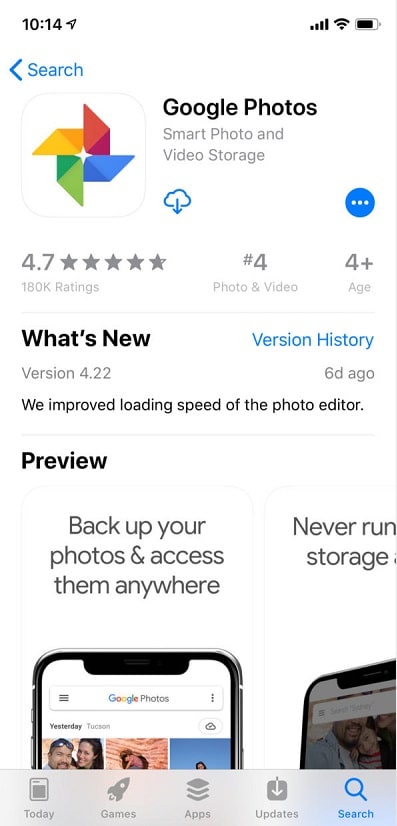
5- Back Up Your iPhone Data to Avoid Data Loss
1. Using iCloud Backup
To begin, link your iPhone to a Wi-Fi network. Then, navigate to the Settings app and tap on your name, followed by selecting “iCloud.” Scroll down within the options and locate “iCloud Backup.” Switch on the “iCloud Backup” option and proceed to tap “Back Up Now” to immediately initiate the backup process. Make sure to verify that the backup is fully completed before moving forward.
![]()
2. Using iTunes on a Computer
Begin by linking your iPhone to a computer using a USB cable. Launch iTunes and pick your device from the list. Navigate to the “Summary” segment and opt for the “Back Up Now” selection. This action will generate a comprehensive backup of all your iPhone data on the computer.
![]()
3. Wondershare Dr.Fone

Wondershare Dr.Fone
One click to back up your iPhone data!
- One-click to back up the whole iOS device to your computer.
- Allow previewing and selectively export from Apple iPhone 11 to your computer.
- No data loss on devices during the restoration.
- Works for all iOS devices. Compatible with the latest iOS version.

3981454 people have downloaded it
The most advanced and reliable phone backup toolkit is Wondershare Dr.Fone because it helps you back up data without worrying about storage space. It also provides the Incremental feature through which your iPhone is backed up without connecting to the computer.
Furthermore, you can preview data stored in your iPhone backup file and restore specific data to your iDevice. It can also restore your iCloud/iTunes backup to your iPhone/Google Pixel without factory resetting the Apple iPhone 11 device.

Part 3: How Many Data Can I Email To Google Pixel?
Thinking about transferring data from Apple iPhone 11 to Google Pixel by Email? Well, it is the best option only if you want to transfer small-size files and not much data. And yes, there is a limit to how many or much data can you email to your new Google Pixel device.
The email size limit is 20 MB for some platforms and 25 megabytes for others. For instance, if you want to send a video from your iPhone to your new Google Pixel device, then the video should be less than 15 or 20 seconds long to share via email.
Part 4: One-Stop Solution to Switch Data From iPhone To Google Pixel
If you want a one-stop solution to transfer data from Apple iPhone 11 to Google Pixel, then you need to rely on a powerful phone-to-phone data transfer software like Dr.Fone - Phone Transfer . With its assistance, you can transfer contacts both in a cloud account and phone memory along with videos, photos, text messages, etc from Apple iPhone 11 to Google Pixel in just one click.
To help you learn how to use Dr.Fone - Phone Transfer program for switching iPhone to Google Pixel 3, below is the simple guide-
Step 1: Get the Dr.Fone - Phone Transfer on your computer and then run it. Then, choose the “Phone Transfer” option.

Step 2: After that, connect both of your devices to the computer and let the software detect them. And ensure that iPhone is selected as a source and Google Pixel as the target and select the files you want to transfer.
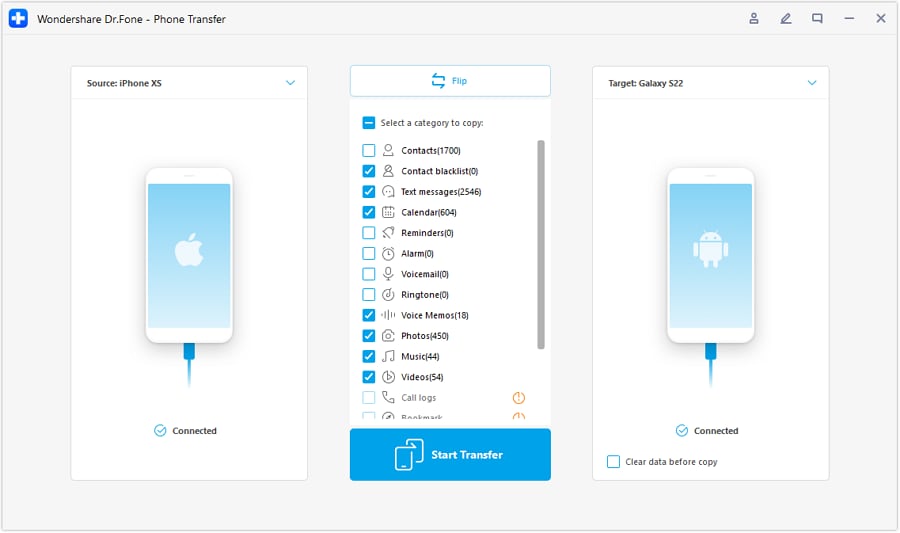
Step 3: Finally, hit the “Start Transfer” button to begin the transfer and that’s it.
And if you ever want to get back to your iPhone, then you would probably wonder how to switch from Pixel to iPhone. In that case, all you need is a phone-to-phone data transfer app like Dr.Fone - Phone Transfer to make the switch successful with all the data you need on your new device.
The Bottom Line
Switching between the iPhone and Google Pixel demands thoughtful deliberation, as evidenced by the ongoing debate. Factors like OS preferences, app compatibility, and data synchronization need to be considered. While the transition process may seem daunting, many tools can simplify the switch. They ensure a smooth experience of switching from Apple iPhone 11 to Google Pixel.
In this context, Wondershare Dr.Fone emerges as a comprehensive and user-friendly solution. It helps you in transferring data from an iPhone to a Google Pixel. With its versatile data transfer capabilities and emphasis on data security, Dr.Fone offers a reliable and efficient data transfer method.
[Solved] How To Transfer From Apple iPhone 11 to iPhone 15
Transitioning to a new iPhone is undoubtedly thrilling. Yet, the process of migrating your data from one iOS device to another can appear overwhelming. With every iPhone model update, Apple unveils new features and functionalities. It can potentially complicate the transfer procedure. In this extensive guide, we’ll simplify the process of how to transfer data from Apple iPhone 11 to iPhone.
We’ll offer detailed, step-by-step guidance and explore many methods to ensure an efficient transition. By the end of this guide, you’ll possess the necessary know-how to effortlessly transfer your valuable data.
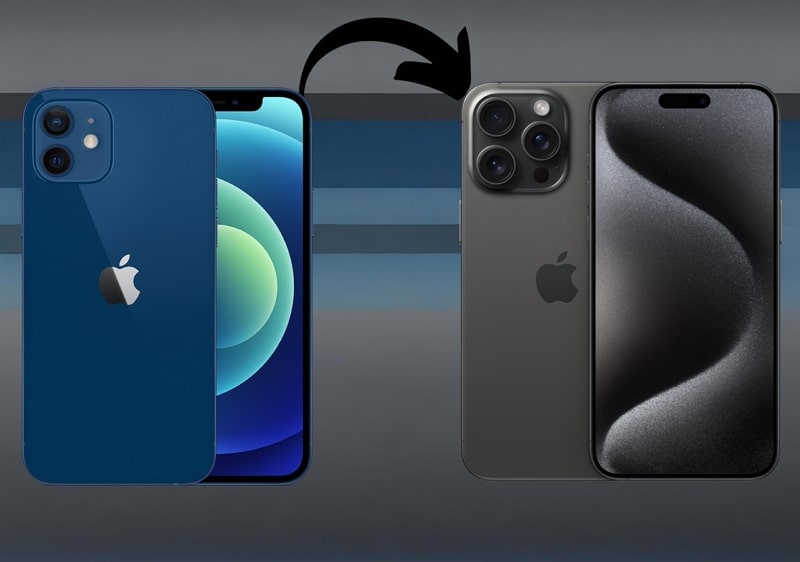
Part 1. How To Transfer Data From Apple iPhone 11 to iPhone With Apple’s Built-In Methods
Moving data from one iPhone to another can be easier using Apple’s tools. These features are already on your iPhone and make it simple and reliable to transfer your data. Given below are the three built-in solutions from Apple for how to transfer data from Apple iPhone 11 to iPhone:
Method 1. Quick Start
The Quick Start feature from Apple offers a way to transfer data from your previous iPhone to a new device without any hassle. This method utilizes a direct wireless connection between the Apple iPhone 11 devices. That makes the transition swift and efficient. Follow these steps to transfer data from Apple iPhone 11 to iPhone using Quick Start:
Step 1. Begin by turning on your new iPhone and placing it beside your old iPhone. When the “Set Up New iPhone” prompt appears, tap “Unlock to Continue.” This process will use the Apple ID associated with your old phone, so tap “Continue” if you’re comfortable with that.

Step 2. An animation will appear on the new iPhone’s screen, and you have to hold this animation up to the camera on your old iPhone. Once the message “Finish on New [Device]“ appears, input your old iPhone’s passcode into the new one and follow the provided setup instructions.

Step 3. When you reach the “Transfer Your Data” screen, opt for “Transfer Directly from iPhone” and confirm the specific settings and data you wish to transfer. This streamlined process ensures a smooth transition to your new device while maintaining the data you want.

Method 2. iTunes/Finder
Another reliable method to transfer data between iPhones is using iTunes/Finder. iTunes is available for Windows or macOS versions before Catalina. The users on macOS Catalina and later versions can use Finder to transfer data. This method allows you to create a backup of your old iPhone and restore that backup to your new device. Here is **how to transfer data to the new iPhone** via iTunes/Finder:
Using iTunes (For Windows or macOS Versions Prior to Catalina)
Step 1. Initiate by connecting your old iPhone to your computer and launching the latest version of iTunes. Once your device is detected by iTunes, click the Apple iPhone 11 device icon to access the “Summary” tab. Here, move to the “Backups” section and click “Back Up Now” to start creating the backup. Before pressing “Back Up Now,” ensure that “This Computer” is selected as a backup location.

Step 2. Once the backup is completed, disconnect the old device and start setting up the new one. When you reach the “Apps & Data” screen, select “Restore from Mac or PC,” and connect to the computer with iTunes.

Step 3. Click the “Device” icon in iTunes when it loads the new iPhone, and you will come across the “Welcome to Your New iPhone” screen. Here, select “Restore from this Backup,” select the targeted backup, and click “Continue.” It will commence the backup restoration process, which takes some time, depending on the backup size.

Using Finder (On macOS Catalina and Later Versions)
Step 1. To start, use a USB cable to connect your old iPhone to your Mac and open Finder. In Finder, select your iPhone under the “Locations” section. Click “Back Up Now” to create a backup of your old iPhone on your Mac. Ensure that the “Back up all of the data on your iPhone to this Mac” box is checked, and when the process is completed, unplug the old device.

Step 2. Now connect the new iPhone with “Restore from Mac or PC” selected from the “Apps & Data” screen. Choose your device in Finder and click “Restore Backup.” Then, select the targeted backup and wait for the backup restoration process to complete.

Method 3. iCloud Backup
Utilizing iCloud Backup offers a streamlined and wireless approach for transferring data. This method empowers you to generate a backup of your previous iPhone on iCloud. Afterward, it enables you to restore that backup to your new device.
Leveraging iCloud Backup facilitates the transfer of various data types. These include photos, videos, app data, settings, and more. The steps to **transfer data from Apple iPhone 11 to new iPhone** via iCloud Backup are these:
Step 1. Confirm that your former iPhone is connected to a reliable Wi-Fi network. Then, access the Settings app on your previous iPhone and tap your name, which is located at the top of the screen. Select “iCloud” and proceed to choose “iCloud Backup.” Ensure the “iCloud Backup” option is activated if it’s not switched on. Finally, click “Back Up Now” and wait for the backup process to finalize.

Step 2. Turn on your newly obtained iPhone and follow the initial setup instructions until you reach the “Apps & Data” display. Once there, select “Restore from iCloud Backup” and sign into your iCloud account. Ensure it is the same Apple ID you utilized to back up your previous iPhone. Afterward, select the latest backup of your previous iPhone and follow the on-screen instructions to complete the process.

Part 2. What Are the Drawbacks of Using Official Methods for Transferring Data From Apple iPhone 11 to iPhone
Apple’s official methods to transfer data from Apple iPhone 11 to iPhone offer convenience and reliability. Nevertheless, they do possess specific limitations and disadvantages. Users should consider these limitations to make a well-informed choice. It will help you find the most fitting approach for their requirements. Here are some of the downsides and constraints associated with Apple’s official methods:
1. Entire Devices Backups
A major drawback of using methods like Quick Start, iTunes, and iCloud is that they restore the entire device’s data. Users cannot selectively transfer data using any of these three methods.
2. iPhone Setup Requirement
The transfer methods like iCloud and Quick Start can only be employed when setting up a new iOS device. For old devices, you must factory reset the Apple iPhone 11 device for these methods to work.
3. Internet Dependency
Restoring iCloud Backup on your new iPhone requires a stable and relatively fast internet connection. This can be a limitation in areas with poor connectivity or limited data plans. If the internet is unstable, it could lead to issues during the iCloud backup restoration.
4. Limited Storage on iCloud
iCloud offers 5 GB of free storage, which might not be sufficient for users with large amounts of data. Users might need to buy more iCloud storage to accommodate their backups, incurring extra costs.
5. Compatibility Issues
Older iPhone models might not support the latest iOS versions or certain features. It leads to compatibility issues when transferring data between devices. This is a prominent issue when dealing with different iOS versions.
Part 3. One-Click Alternative to Official Methods To Transfer Data From Apple iPhone 11 to iPhone
Seeking an efficient, all-in-one solution that bypasses the limitations of Apple’s official methods? Wondershare Dr.Fone stands out as a comprehensive alternative. It offers a one-click approach to transferring data between iPhones of various models. This toolkit streamlines the process without relying on iCloud or iTunes/Finder. Dr.Fone also provides a user-friendly interface that simplifies the transfer process.
Its intuitive design allows users to transfer data between iPhones effortlessly. Unlike Apple’s native methods, Dr.Fone enables the transfer of over 15 types of data. This includes contacts, messages, photos, videos, music, call logs, apps, and more. It supports transferring data between different iOS versions and iPhone models.
Key Features of Wondershare Dr.Fone
- Beyond direct transfers, Wondershare Dr.Fone offers backup and restore functionalities.
- Fone – Phone Transfer is compatible with over 8000 devices from various brands.
- This tool enables swift data transfer between phones in under 3 minutes.
Steps to Transfer Data from Apple iPhone 11 to iPhone via Wondershare Dr.Fone
Dr.Fone supports effortless data transfer across devices and platforms. This is how to transfer data from Apple iPhone 11 to iPhone via Wondershare Dr.Fone:
- Step 1. Access Phone Transfer and Connect iOS Devices
Launch Wondershare Dr.Fone after installing it and access the “Toolbox” tab. Here, click “Phone Transfer” and connect both of your iOS devices to the computer. Once they are detected by Dr.Fone, move to assign them to the correct positions.

- Step 2. Pick Source and Destination Positions
Your old iPhone from which you are transferring data will be the “Source” device. Similarly, your new iPhone to which you want to move data will be in the “Destination” position. In case positions are wrong, use the “Flip” button to interchange the positions.
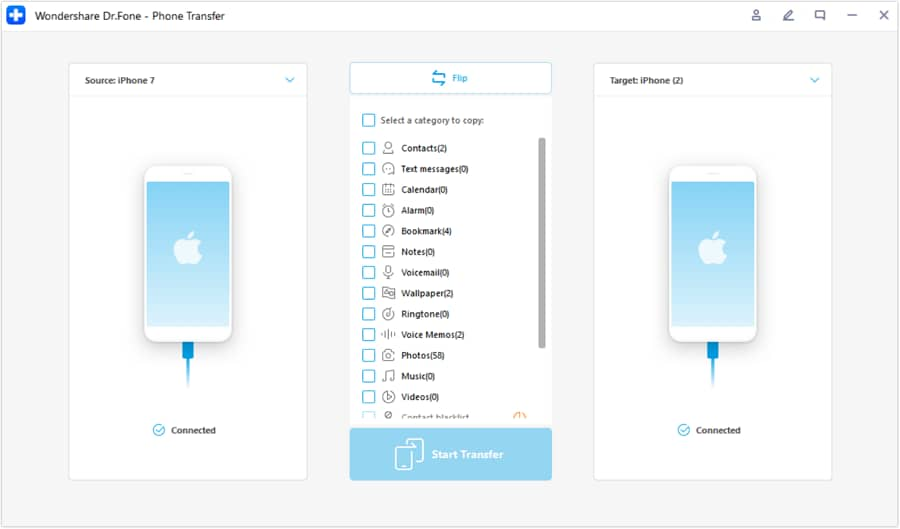
- Step 3. Start and Complete the Data Transfer Process
The last part includes selecting the data you want to transfer. You can select the data within the transfer screen and, upon making your choices, proceed by clicking “Start Transfer.” It’s important to note that during this process, you’ll need to deactivate the “Find My” feature on iOS devices. When done, the data process will commence automatically.
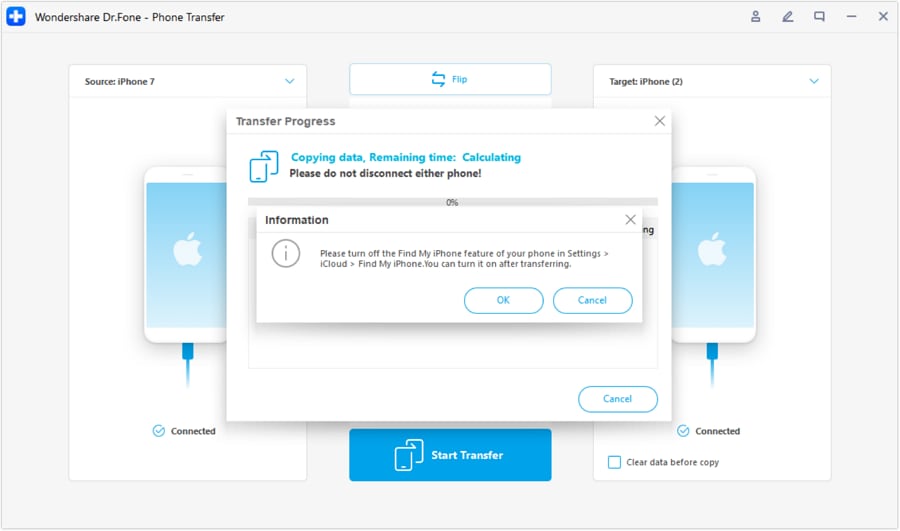
Bonus Tip. Want To Buy a New iPhone? Tips and Tricks To Select the Best iPhone for Your Use
Choosing the right iPhone involves considering various factors. Ensuring alignment with your preferences, needs, and budget is crucial. It requires evaluation of these aspects and conducting comprehensive research. This will enable you to confidently make a knowledgeable choice. Below, discover some helpful tips and tricks to aid in choosing the ideal iPhone:
1. Identify Your Priorities
Determine what matters most to you in an iPhone model. Are you more focused on camera quality, battery life, processers, or other features? Gaining clarity on your priorities will assist in focusing your choices.
2. Consider the Latest Models
Apple releases new iPhone models annually. Consider the latest offerings, as they often feature upgraded hardware. This includes improved cameras, better battery life, and new features.
3. Budget Consideration
Set a budget range for your new iPhone. Apple provides a range of models available at diverse price tiers. These range from flagship iPhones to more budget-friendly options. Consider your budget while weighing the features you need.
4. Size and Display Preferences
iPhones come in different sizes, from compact models like the iPhone 15 to larger models like the iPhone 15 Pro Max. Consider the screen size of your iPhone that suits your preferences. It also depends on if you prefer a more pocket-friendly device or a larger display.
5. Camera Capabilities
If photography holds significance for you, examine the camera capabilities. Seek out attributes such as multiple lenses, improved low-light performance, and advanced camera functionalities.
6. Consider Future Updates and Longevity
Opt for the latest Apple device, as the company provides software updates for its products over an extended period. Selecting a model with longer update support ensures that your device stays compatible with the latest software and features.
Conclusion
In conclusion, knowing how to transfer data from Apple iPhone 11 to iPhone is crucial for a smooth transition. While Apple’s native methods offer reliability, limitations exist. For an efficient, one-click alternative, Wondershare Dr.Fone stands out. Its comprehensive device-to-device transfer and versatile features make it the ideal choice. Embrace Dr.Fone for a hassle-free iPhone data transfer experience. Moreover, you can transfer between iOS devices without erasing the current data.
Also read:
- [New] 2024 Approved Quintessential Quests & Thrills – Top 10 Games
- [Updated] 2024 Approved Master the Art of Customization for YouTube Shorts Thumbnails
- [Updated] Top 10 Online Hubs for Public Domain Music in Games
- 5 Ways to Transfer Music from Apple iPhone XR to Android | Dr.fone
- 6 Methods for Switching from Apple iPhone 6s to Samsung | Dr.fone
- Android Safe Mode - How to Turn off Safe Mode on Vivo Y27s? | Dr.fone
- Discover the Cutting-Edge Functionality of EmEditor Pro 9.00 Alpha Version 21: The Ultimate Text Editing Solution
- Hassle-Free Steps for Surface Dock Driver Installation – Latest Methods
- How to Transfer Apple iPhone 6 Plus Data to iPhone 12 A Complete Guide | Dr.fone
- In 2024, 4 Quick Ways to Transfer Contacts from Apple iPhone 6 to iPhone With/Without iTunes | Dr.fone
- In 2024, Various Methods to Transfer Pictures from Apple iPhone 12 Pro to PC | Dr.fone
- iPhone Transfer Transfer Contact from Apple iPhone 15 Pro to iPhone without iCloud | Dr.fone
- Refurbished Apple iPhone SE Everything You Need to Know | Dr.fone
- Switch Cards Between Apple iPhone 12 and other iPhones Will Move All Phone Services? | Dr.fone
- The 10 Best Tools to Bypass iCloud Activation Lock On iPhone 12 Pro You Should Try Out
- Update Alert! Your PC Needs a DirectX 11 GPU for Optimal Performance
- Updated In 2024, Music Video Magic 10 Essential Software and Apps for Creators
- Title: In 2024, How to Copy Contacts from Apple iPhone 11 to SIM? | Dr.fone
- Author: Charlotte
- Created at : 2024-10-08 00:17:57
- Updated at : 2024-10-11 18:11:05
- Link: https://iphone-transfer.techidaily.com/in-2024-how-to-copy-contacts-from-apple-iphone-11-to-sim-drfone-by-drfone-transfer-from-ios/
- License: This work is licensed under CC BY-NC-SA 4.0.

